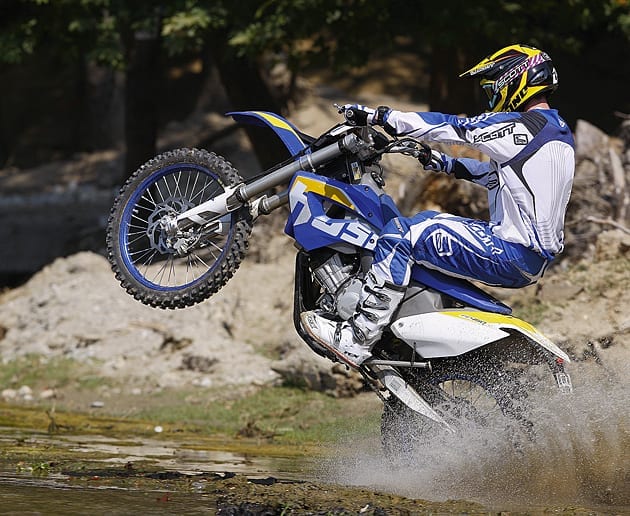Red Hot! - The all-new 2009 Honda CRF450R
By TMX Archives on 9th Oct 08

The all-new 2009 CRF450R is just that all-new but are all the changes worthwhile and is the new open class Honda really a must-have MX1 missile?
ALL-NEW from the ground up - only five parts are the same as this year's model - the 2009 CRF450R is one of the most exciting motocross bikes to be released to the public in quite some time. Radically different in looks the new Honda is also claimed to be faster, lighter, sweeter handling and more reliable too.
CRF450Rs have been around for seven years already and since 2002 they have - in my opinion - been the best 450cc four-stroke motocross machine available as standard. Fast, reliable and not too ropey in the handling department either it's little wonder that they fly as fast from showroom floors as they do out on the track.
It was rumoured that Honda had something special for us in 2009 and when the first pictures of the new CRF450R were released it was obviously true. One of the first things you'll notice about the new bike is that the exhaust pipe wraps around the front of the aluminium frame's down tube. This is to allow the weighty silencer to be positioned further forward on the bike in an effort to centralise mass and lower the centre of gravity.
In fact, many of the chassis changes on the new bike are to help achieve that goal and some changes - including the short and stumpy shape of the rear shock gas bottle - and necessary to facilitate the overall changes.
The new bike comes with a batteryless fuel-injection system that is promised to enhance performance and offer a wider and improved range of power. The injection system is fed by a fuel pump that's housed inside the 5.7-litre fuel tank and is powered by a generator that only produces power when the motor is turning over. That means that as soon as the motor stops running the fuel stops flowing too which does away with the need for a fuel tap.
But the fuel-injection system is just the icing on the cake. The aluminum frame is the fifth generation of Honda's Twin-Spar design and there have been a lot of geometry changes made in an effort to improve steering and overall handling. As an example the swinging arm is 18mm longer and the triple-clamp offset has been reduced two millimeters from 22 to 20mm.
The excellent Honda Progressive Steering Damper is still hidden away behind the front number plate to help do away with any scary high-speed tank slappers which are normally inevitable on a big-bore bikes like this.
Honda claim that the motor makes big power for 2009 but in a more useable manner - that's smart thinking because 450s can be a bit of a handful and that undoubtedly puts many people off when it comes to buying the beasts. It seemed that Honda have done their best to make this bike more friendly to the masses and that's why I was so excited to test this race machine for myself.
The circuit used for this initial test was the hillside Faenza track that's situated just south of Bologna in Italy just one day after the MX1 and MX2 world championship deciding Grand Prix of Citta di Faenza. As you can imagine after two days of abuse from the world's leading riders the circuit was rougher than a bear's backside and with overnight rain falling too the normally baked-solid hardpack surface was wet and sticky making it almost ideal British conditions.
After years of riding CRF450Rs I know the drill when it comes to firing them up. Take the motor just past TDC then give one steady prod on the kickstart lever and the motor will burble to life. The 2009 model is no different - kick it hard and fast and you'll be booting it forever, kick it right and the motor will come to life just like that.
Honda knows how to make a solid motor and the new CRF is surprisingly quiet both mechanically and from the exhaust out on the track. With a 50mm throttle body - replacing a 41mm carb - I was expecting to hear more induction noise but was left feeling disappointed when I blipped the motor.
Out on the track there are two things you notice within three corners - this bike feels light and the carburetion is always perfect. With the PGM-FI unit calculating how much fuel to deliver constantly - taking engine revs, throttle position, coolant temperature and ambient air pressure and temperature into consideration - there's never a time when the jetting isn't perfect. I know the word jetting isn't technically correct but until there's a universally acceptable word to replace it I'm going to continue to use it.
Although the metered fuel delivery is perfect under normal circumstances the fuel injection system isn't able to overcome rider idiocy so it's still very possible to bog the engine and pop-stall the motor if you expect it to pick-up from low revs under heavy load when you're in way too high a gear - it can't perform miracles but it's not far off.
The spread of power is quite amazing. From low revs up, right through the range the delivery is smooth and linear. It's so good that it's almost possible to use third gear for an entire lap - lap after lap - even though shifting through the five-speed gearbox was effortless, making it a dream to ride.
The large amounts of low-end grunt available helps pull the bike hard out of tight turns from minimal revs before the motor impressively keeps on pulling hard through the mid to top-end and beyond. It's an engine that will keep almost every rider happy and although it makes the best of its power between 7,000 and 8,500 rpm the wide overall spread of power is enough to keep the short-shifters as well as the hard revvers happy too.
While the motor's good it's the revised chassis that makes this bike so enjoyable to ride...
At a shade under 107kg the CRF450R is far from being light when compared to its classmates but due to the way the weight is placed it feels much more feathery than any 450 four-stroke ever has before. To borrow a phrase from almost every other test-rider at Faenza 'this bike rides like a 250F' and if it weren't for the phenomenal power the motor produces I'd agree!
Unless there's a nice rut or berm to turn off 450s are generally hard to change direction on as they like to push on through corners - especially on hardpack. But the new CRF450R will change the way many people perceive open class bikes to be.
For 2008 Honda changed the fork offset to 22mm which helped quicken the CRF's steering and for 2009 it's now 20mm. That change along with the way the mass is now more centralised on this new bike means that this machine turns on a tuppence and swivels on a sixpence. Not only is it possible to change direction quickly it's possible to do it with much less energy expended than on older models and this is where most riders will benefit.
Overall handling is good. Set the sag correctly and you'll be rewarded with a well balanced, sweet handling bike that not only turns well but behaves itself on acceleration and braking bumps too. Even in big-hit situations like landing short on doubles or over-jumping tabletops - you have to understand that I only did this for test purposes - the suspension works predictably and efficiently with no harshness in the stroke or excessive bottoming out.
As with any new bike on the market today the braking performance was perfect with plenty of progressive stopping power and not a hint of fade even on the longest of downhills. The Nissin brakes found on Hondas have been class-leaders for around 15 years now so that's not an area in which I expected to be disappointed.
In fact there's only one area of the Honda's performance that I felt let down by - starting when hot. Four-strokes can be a pig to restart after a crash or stall, especially when they're up to operating temperature and this bike seems to be one of the worst. Whether it's the lack of a hot-start lever, bad programming or just the fault of the guy who was kicking it there was no way I could get this bike to start quickly when warm. Maybe you'll have more luck than me or Honda will have reprogrammed the PGM-FI unit by the time they hit the shops or maybe its time for push-button starting a la KTM?
Overall, I was generally amazed by the new bike's performance. If you're not convinced then I plead with you to at least try one for yourself at one of the many Honda test days there are bound to be this autumn because at the very least a ride on the new CRF450R might just change the way you think about 450 motocross bikes forever.
SPECIFICATIONS
Engine: Liquid-cooled four-stroke four-valve SOHC single
Displacement: 449cc
Bore and Stroke: 96x62.1mm
Compression Ratio: 12:1
Max Power: 41.5kW @ 8,500 RPM
Max Torque: 50.3Nm @ 7,000 RPM
Carburetion: PGM-FI electronic fuel injection
Fuel Tank Capacity: 5.7 litres
Ignition: Full transistor with digital ignition
Transmission: Five-speed
Frame: Aluminium twin-spar
Wheelbase:1,491mm
Seat Height:954mm
Ground Clearance: 332mm
Weight:106.9kg
Front Suspension: 48mm Kayaba fork (310mm travel)
Rear Suspension:Kayaba shock absorber (320mm travel)
Front Brake: 240mm Disc Brake
Rear Brake: 240mm Disc Brake
Specification:
